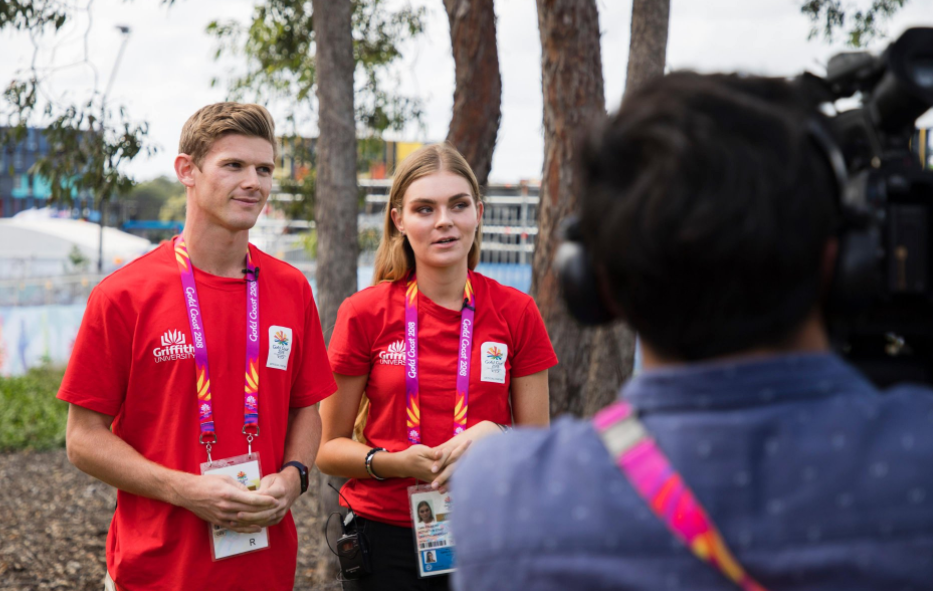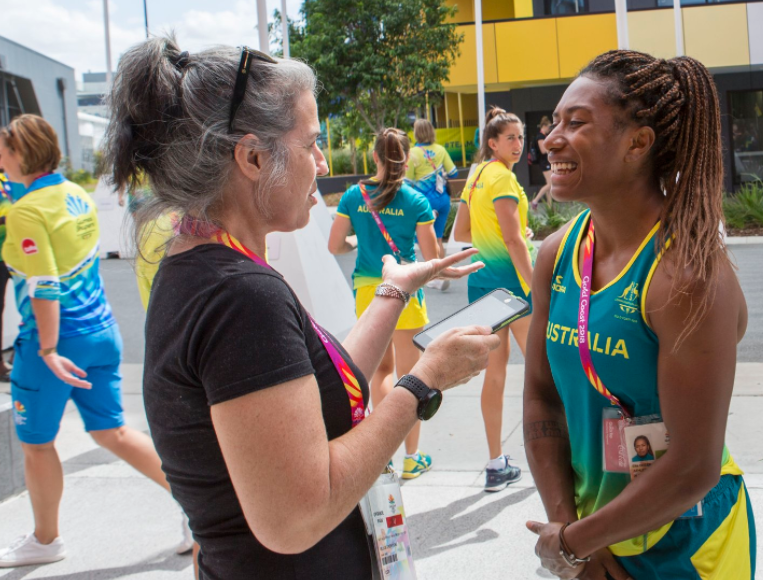For three hectic weeks, around 40 Griffith University students had an opportunity that many reporters would envy: having access to and reporting on the Commonwealth Games at the Gold Coast.
Based from a pop-up newsroom at the Gold Coast campus for the duration of the Games, journalism, photography and public relations students were embedded alongside working journalists and Editors from Fairfax to produce eight editions of a special newspaper for the Athletes Village — called the Village Source.
It was a real-life working newsroom environment, and some students buckled under the pressure with tears and even vomiting as deadlines loomed.
But by the end of the Games, the struggles evened out with the incredible highs they experienced, with students having stories featured on national publications such asBrisbane Times, Sydney Morning Herald, Canberra Times, andalso more than 10 radio stories broadcast on national radio showThe Wirearound Australia.
Journalism student Demi Lynch says being part of a working newsroom was an incredible opportunity.
“It’s good – I get the real experience of what it’s like to be a journalist in a journalists’ environment, but it’s also a bit of preparation as well for how much stress you will have to go under,” Demi said.
“So it’s a lot of loss of sleep, lots of junk food and constantly getting messages every single minute about the most minimal updates ever — so yes I feel like a real journalist.
“I don’t learn very well from theory so being able to just put it out there and have to deal with all the stories ourselves – we’re not being babied.”
While journalism student Georgia Costi learnt how a story develops in real time.

Village Source journalism student Georgia Costi shows off her interviewing skills
“What I found is we always watch the news and read the news, but you always think `how does the news get the news?’. I feel like that’s what I’ve learnt from this experience,” Georgia said.
“It’s like you have to chase one small thing and from that a story forms, and I didn’t really think about that until I did this.
“It’s cool we’ve spoken to people we’d normally never get to. It’s been hard but good.”
Jake Gallagher, who wrote two of the front page stories for The Village Source, says being part of a working newsroom gives him an edge that other journalism students lack.
“I interviewed British diver Tom Daley, he was also with Grace Reid who is normally his synchro partner in the Olympic Games for Great Britain, but she’s Scottish so she is competing for a different nation in the Commonwealth Games than he is, so there’s a bit of friendly rivalry there. It was a good experience to interview them,” Jake said.
“It’s chucked me into the deep end – you pretty much sink or swim as such, it’s good because it gives you the experience you need when you’re doing it as a professional.

Village Source Journalists on the job during the Games
“The best bit has probably been just being able to get advice and experience from professionals and getting people that are actually working in the field to sub your stories and find out where you can improve.”
Deputy Editor and PhD candidate Audrey Courty said it was a fast paced learning environment.
“There are things you learn in these pop up newsroom experiences that you otherwise wouldn’t in the classroom,” Audrey said.
“Over time it’s been great to see them evolve and doing interviews on their own, building up their confidence to approach athletes or people they don’t know and have a conversation.
“Learning how to work on a deadline — that’s one thing I don’t think they really have a strong grasp of.
“You’re seeing it put the pressure on the first couple of weeks, we had breakdowns we had tears, we even had someone spew, we had it all but now you see they’ve got a sense of the workflow and they’re coming in a bit more ready and getting used to that pressure.”
Journalism Lecturer in the School of Humanities Faith Valencia-Forrester says the success of the newsroom shows the value of work-integrated learning.

Faith Valencia-Forrester interviews Australian Rugby Sevens player Ellia Green
“It gives the students a practical base to understand the work practices of journalism,” Faith said.
“But what makes these kinds of events significant is that it gives these students access to internationally renowned athletes, media identities, people that are working in an event scenario that normally if they were a journalism student they would not have that access.
“We’ve got a Fairfax editor in our newsroom laying out the paper for them. So not only are they working in that environment they’re able to see how professionals and industry practitioners are doing their job and they’re right there in the trenches working alongside them.”
Cameron Atfield is usually the Afternoon Editor for Fairfax publication The Brisbane Times, but enjoyed his time working with the students on a newspaper again.
“These sorts of exercises separate the field a bit, it’s fair to say that, a few have risen to the challenge, a few have crashed and burned. But that’s what you expect,” Cameron said.
“The ones who make it through here are the ones who are going to be a journalist in today’s landscape.
“It’s been a great experience and I really think that it’s going to hold a lot of these guys in good stead going forward if this is the career that they want to pursue — if it hasn’t frightened them off!”
To listen to a podcast of the students’ experience, click below.
